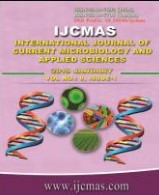


 National Academy of Agricultural Sciences (NAAS)
National Academy of Agricultural Sciences (NAAS)

|
PRINT ISSN : 2319-7692
Online ISSN : 2319-7706 Issues : 12 per year Publisher : Excellent Publishers Email : editorijcmas@gmail.com / submit@ijcmas.com Editor-in-chief: Dr.M.Prakash Index Copernicus ICV 2018: 95.39 NAAS RATING 2020: 5.38 |
Nagpuri buffalo is native to Nagpur region of Maharashtra.The Nagpuri buffaloes are moderately good milk producers. Their milk is of very good quality containing around 7.7 percent of fat. Most of the people especially children depend on local vendors for buffalo milk. Alteration in physicochemical /microbiological parameters has direct impact on the quality of milk. Growing evidence those foods borne pathogen directly or indirectly causes or predispose man to chronic diseases. The present study is conducted to analyze the physiochemical and microbiological quality of raw milk by employing clot on boiling test, California mastitis test, titrable acidity, methylene blue reduction test and again the same sample were processed for identification of differential food borne pathogen by using Himedia differential food borne pathogen commercial kit. A total of 40 different Nagpuri buffalo milk samples were collected from different areas in Nagpur city. Sample collected directly into the sterilized milk collection bottle and subjected to analysis in the laboratory. Out of 40 samples buffalo milk, 22 samples (55 per cent) shown titrable acidity more than 0.18% and five (12.5 per cent) with CMT positivity. The COB and MBRT turned negative for all the samples tested and. Total viable count is under acceptable range. By using bacteriological commercial kit, Out of total 40 samples, seven samples became positive for E. coli (17.5%), one for Salmonella (2.5%), one for Vibrio (2.5%), nine for Listeria monocytogenes (22.5%) and two for Staphylococcus aureus (5%). In conclusion, from the above result it is concluded that the presence of pathogens in milk samples is the matter of concern from public health point of view. Further, the bacterial contamination may be contributed to less hygienic practices followed with respect to udder health management.
 |
 |
 |
 |
 |